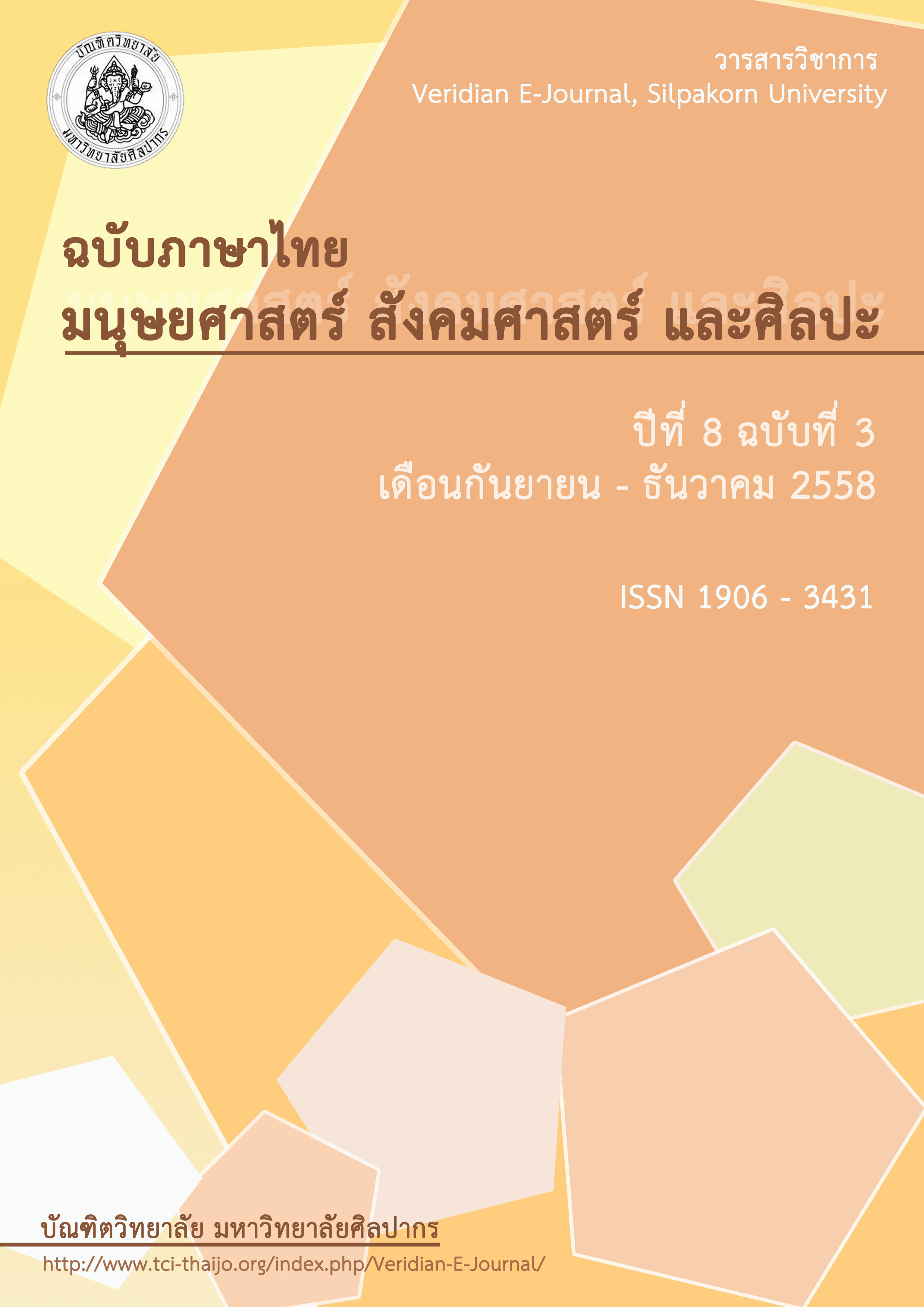การใช้ภาพความตายเป็นสื่อสัญลักษณ์ในงานศิลปะร่วมสมัยไทย (2545-2555)
Main Article Content
บทคัดย่อ
บทคัดย่อ
การศึกษาครั้งนี้มีวัตถุประสงค์เพื่อศึกษาและทำความเข้าใจการใช้ภาพความตายเป็นสื่อสัญลักษณ์ในการสร้างงานศิลปะร่วมสมัยไทย โดยได้ทำการศึกษาผลงานศิลปะร่วมสมัยไทยที่อยู่ในช่วงเวลา 10 ปีที่ผ่านมา (พ.ศ. 2545-2555) ที่มีการใช้ภาพความตายอย่าง ศพ โครงกระดูกและหัวกะโหลกในผลงาน
จากการศึกษาพบว่าภาพความตายถูกนำมาใช้ในงานศิลปะอย่างหลากหลาย โดยที่ศิลปินได้ใช้ภาพความตายเพื่อเชื่อมโยงกับบางสิ่ง ซึ่งการสำรวจผลงานประกอบข้อมูลจากเนื้อหาซึ่งได้จากหลักฐานเอกสารเกี่ยวกับผลงานชิ้นนั้นๆ ทำให้สามารถแบ่งความสัมพันธ์ระหว่างเนื้อหาและภาพความตายออกเป็น 6 กลุ่ม คือ 1.กลุ่มภาพความตายสัมพันธ์กับชีวิตและความตาย 2.กลุ่มภาพความตายสัมพันธ์กับปรัชญาศาสนาและความเชื่อ 3.กลุ่มภาพความตายสัมพันธ์กับสังคม 4.กลุ่มภาพความตายสัมพันธ์กับการเมือง 5.กลุ่มภาพความตายสัมพันธ์กับจิตใต้สำนึก 6.กลุ่มภาพความตายสัมพันธ์กับธรรมชาติ
เมื่อได้ทำการแบ่งกลุ่มภาพความตายจึงเป็นผลมาสู่การวิเคราะห์ภาพความตายเชื่อมโยงกับสังคมร่วมสมัยไทยที่สถานะทั่วไปของภาพความตายเป็นเรื่องที่น่ารังเกียจ ขยะแขยงอันส่งผลต่อบทบาทของภาพความตายที่ถูกนำเสนอในงานศิลปะ เมื่อพิจารณาแล้วสามารถแบ่งภาพความตายในงานศิลปะร่วมสมัยไทยออกเป็น 2 ลักษณะ 1.ภาพความตายที่มีลักษณะไม่ขัดแย้งกับแนวคิดสังคม กล่าวคือ ภาพความตายถูกนำเสนอโดยไม่ขัดแย้งกับการรับรู้ทั่วไปของสังคม ซึ่งศิลปินมีกลวิธีในการนำเสนอ เช่น นำเสนอภาพความตายผ่านงานทัศนศิลป์ ประเภทจิตรกรรมและประติมากรรมหรือการนำเสนอด้วยความงามทางศิลปะ เป็นต้น 2.ภาพความตายที่มีลักษณะท้าทายกับแนวคิดสังคม กล่าวคือเป็นภาพความตายที่มีลักษณะท้าทายกับแนวคิดส่วนใหญ่ของสังคม ซึ่งศิลปินมีกลวิธีการนำเสนอ เช่น การนำเสนอความจริง อย่างศพจริง หรือการนำเสนอผ่านวีดิทัศน์และภาพถ่าย เป็นต้น
Abstract
The objective of this study is to study and understand the use of death pictures as symbols in the creation of Thai contemporary arts. The study explores Thai contemporary arts that use death pictures such as corpses, skeletons and skulls over the ten-year period (2002 -2012). The study finds that death pictures have been used widely in art works. Artists use such pictures to connect with something. From the survey of artworks together with information from documents about those works, the relationship between content and death pictures can be categorized into 6 categories: 1.The death pictures in relation to life and death 2. The death pictures in relation to religious philosophy and belief 3. The death pictures in relation to the society 4. The death pictures in relation to politics 5. The death pictures in relation to subconscious 6. The death pictures in relation to nature. After such categorization, this study further analyzes the death pictures in connection with the contemporary Thai society, in which the death pictures are considered disgusting. This, in turn, affects the role of the death pictures presented in the artworks. The death pictures in Thai contemporary arts can be synthesized into two main types: 1. The death pictures that are not contradictory to the society. This means that the death pictures are presented without any conflicts with general perceptions of the society. Under this type of artworks, artists use various strategies and modes to present their work such as visual arts, paintings, sculptures or other aesthetic forms of art. 2. The death pictures that challenge the concept of the society. This means that the death pictures are presented with challenges to the general perceptions of the society. Under this type of artworks, artists use various strategies such as using real corpses or presenting the reality through videos and photos.

